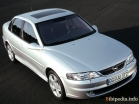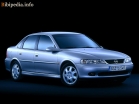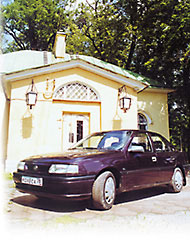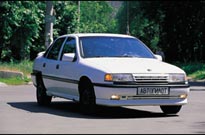Test drive Opel Vectra sedan 1999 - 2002 sedan
DOLOD WORK TO PERFORMATION
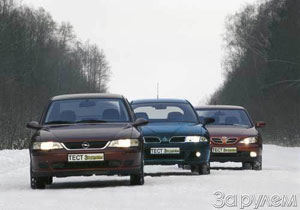 The second generation of Opel-Vetre debuted in 1995. Four years later, the car was restored. Sedan, hatchback and station wagon are produced. Engines - ecotek series: gasoline, with a volume of 1.6 (eight and sixteen -valve); 1.8; 2.0; 2.5 liters, as well as two options for a 2-liter turbodiesel (82 and 100 l.). Gearboxes - a five -speed mechanical or four -speed automatic (only with gasoline motors).
The second generation of Opel-Vetre debuted in 1995. Four years later, the car was restored. Sedan, hatchback and station wagon are produced. Engines - ecotek series: gasoline, with a volume of 1.6 (eight and sixteen -valve); 1.8; 2.0; 2.5 liters, as well as two options for a 2-liter turbodiesel (82 and 100 l.). Gearboxes - a five -speed mechanical or four -speed automatic (only with gasoline motors). Mitsubishi Karisma has been produced at the Nedkar factory in Holland since 1995, and a year ago, in 1999, it was modernized. The body is a sedan and a hatchback. It is equipped with gasoline engines of 1.6 and 1, 8 liters (the latter - type GDI with direct fuel injection into the cylinders) or 1.9 -liter turbodiesel. All motors can be aggregated with a five -speed manual gearbox, and gasoline, in addition, with a four -speed automatic.
The Nissan Primer, manufactured in Sanderland (England), acquired the current species in 1999 after the deep modernization of the second-generation model of the 1996 model. Sedan, hatchback and station wagon are produced. Gamma of engines includes gasoline units with a volume of 1.6; 1.8 and 2.0 liters or turbodiesel 2.0 liters. A mechanical five -speed gearbox is installed on all machines, and a cereal cavity is also provided for the most powerful gasoline.
 Models of leading world firms live on the conveyor of six to eight years, under this time one, less often two modernization, and then replaced by new ones, but almost certainly under the same, well-known name. That is why the biographies of three middle -class cars that have visited our test are so similar. All of them gather in Europe, since they are intended for this market, everyone appeared in the mid-90s and modernized at the end of the decade. For a greater similarity, we selected exactly the same cars - sedans with stopping engines with a volume of 1.6 liters and mechanical gearboxes, in similar trim levels - and, as a result, close in price: Opel Vectra - $ 18,500, Mitsubishi Carisma - $ 17,500, Nissan- Example (ZR, 1999, No. 9) - $ 17,300.
Models of leading world firms live on the conveyor of six to eight years, under this time one, less often two modernization, and then replaced by new ones, but almost certainly under the same, well-known name. That is why the biographies of three middle -class cars that have visited our test are so similar. All of them gather in Europe, since they are intended for this market, everyone appeared in the mid-90s and modernized at the end of the decade. For a greater similarity, we selected exactly the same cars - sedans with stopping engines with a volume of 1.6 liters and mechanical gearboxes, in similar trim levels - and, as a result, close in price: Opel Vectra - $ 18,500, Mitsubishi Carisma - $ 17,500, Nissan- Example (ZR, 1999, No. 9) - $ 17,300. First of all, we note that all three machines have a fit of the face to the benefit: Vectra frowned a little and protruded her lip, showing a more assertive character; Carisma gained individuality, getting rid of unflattering resemblance to a less prestigious Lancer; An example has ceased to be a gray mouse and is now remembered at first glance. Large fifteen -inch wheels associated with massive brakes and a powerful engine make it possible to look more expensive than an opponent with a smaller shoe size. Mitsubishi attracts attention with a significant road clearance - for Russia it is increased from 155 mm (without that for a foreign car) to 170. However, this dignity also turned out to be the flip side, but about it a little further.
 ... Frost makes his way - it's time to check in the action of the electric heating of the seats, very well provided on all three machines, the stoves, and at the same time the comfort of the plastic -veluri interiors. In order not to be repeated in the future, we immediately note some common positions in the trim levels: ABS, two frontal airbags, central locking, immobilizer, electrical drives and front (Mitsubishi also have rear) windows, steering wheel amplifier and a column adjustable in the corner, installation of climate control (Opel simply has air conditioning), an audio system (Nissan audio training), fog lights (except Opel), headlight washer (except Mitsubishi).
... Frost makes his way - it's time to check in the action of the electric heating of the seats, very well provided on all three machines, the stoves, and at the same time the comfort of the plastic -veluri interiors. In order not to be repeated in the future, we immediately note some common positions in the trim levels: ABS, two frontal airbags, central locking, immobilizer, electrical drives and front (Mitsubishi also have rear) windows, steering wheel amplifier and a column adjustable in the corner, installation of climate control (Opel simply has air conditioning), an audio system (Nissan audio training), fog lights (except Opel), headlight washer (except Mitsubishi). When describing Opel-Vetre, the most will determine the most: the largest doorways, the most spacious interior, the largest ranges of adjustments-longitudinal, driver's seat and tilt of the steering wheel (as many as 24 versus competitors). What can you do, on a beer diet, the stomach rests on the steering wheel much faster than in rice, and the Germans know this very well. They are traditionally scrupulous in safety matters: not only the front, but also the rear belts are regulated in height, in addition to two frontal two side pillows appeared, and the alarm is installed at the factory. But not everything is so good: a wide central console leaves not a lot of legs space, and somewhere behind its base is the accelerator pedal. Despite large adjustments, it is not always possible to find optimal. Archaic control of lighting - stretching on itself by a switch; You look for the buttons of electric windows on the doors, and they are on the central tunnel; Obviously not enough lighting of the salon with one modest light in the center.
 Now we quickly jump in Mitsubishi Carism. Here ... Fir-shaft Christmas trees! The concave frame of the back door strives to go along the physiognomy. Yes, and you have to slam the door pretty. The salon here is the most modest sizes: three in the back is closely both width and in height, and the front passenger, bending over, rests on the visor. But they conquer the seats. And it's not even five adjustments for the driver. They are just very convenient - moderately soft, with beautiful, but unobtrusive side support and recordly long, almost to the knee, pillow. In such a chair you can strain, depicting Schumacher, and high on the far flight, having fun with the flight comprehensive compliance. But the range of steering adjustments was shifted down - even with a height of 175 cm, the driver strives to lift the steering wheel to the stop. The high light turns on, and turns off, and flashes with a single click on the steering wheel switch - you still need to get used to it. Nevertheless, according to the total assessment, the driver's place here turned out to be the most convenient.
Now we quickly jump in Mitsubishi Carism. Here ... Fir-shaft Christmas trees! The concave frame of the back door strives to go along the physiognomy. Yes, and you have to slam the door pretty. The salon here is the most modest sizes: three in the back is closely both width and in height, and the front passenger, bending over, rests on the visor. But they conquer the seats. And it's not even five adjustments for the driver. They are just very convenient - moderately soft, with beautiful, but unobtrusive side support and recordly long, almost to the knee, pillow. In such a chair you can strain, depicting Schumacher, and high on the far flight, having fun with the flight comprehensive compliance. But the range of steering adjustments was shifted down - even with a height of 175 cm, the driver strives to lift the steering wheel to the stop. The high light turns on, and turns off, and flashes with a single click on the steering wheel switch - you still need to get used to it. Nevertheless, according to the total assessment, the driver's place here turned out to be the most convenient. What will delight Nissan premer? The convenience of planting and lifting, spaces in the back - in the backs of the front seats of the recess for knees, a voluminous mess. At the same time, the elements of the interior eat a lot of places: the front panel, the console, pocket-rings-lumbering pins on the doors. Original, but controversial shape of the handle on the lever of the box - like a faceted, expanding upward neck of a decanter. It is a pity that the handle of the headlight corrector with its clear symbols was driven into an absolutely invisible zone - under the right elbow. This is all the more inexplicable in the machine, the instructions for which carefully warns against using the cigarette lighter in motion, so as not to be distracted from control. Unlike the two previous machines, the doors lock buttons are not visible from the outside, and the electric windows do not have a delay in de -energization when the ignition and the end of the return - the return, if some object, say, the fingers of the gaping passenger, say, fell under the closing glass.
Warm up in turn in three salons, the body came to life - the desire to steer was awakened.
Opel Vectra did not want to sharply start sharply - the skid wheels dancing on the asphalt, causing the vibration of the front. The second attempt - the result is the same - the accelerator pedal is very acute and dose gas supply, especially on slippery coating, must be carefully. But the steering wheel is good and optimally combines lightness and informativeness. Which is very helpful. It is problematic to regulate the trajectory with an accelerator pedal, at least on a slippery road. Vectra reacts to the discharge or supply of gas with great reluctance.
 The outer mirrors of the vetera, no doubt, are the most stylish, but give the narrowest viewing sector, a third less than, say, in carisms.
The outer mirrors of the vetera, no doubt, are the most stylish, but give the narrowest viewing sector, a third less than, say, in carisms. Opel seemed a little noisy in motion. Having believed the harmony of the algebra, they received confirmation - yes, indeed, the noise level is higher than that of rivals, 2-6 decibels in almost all modes, although the motor is quite quiet. But the stove here is the most vocal.
Mitsubishi Carisma proved to be the exact opposite: lively, rather sharp in reactions, with a fairly sharp steering wheel. (By the way, the steering wheel herself is unexpectedly large diameter.) And if you take into account the good bottoms of the motor and the ability to easily adjust the steepness of the gas supply path, starting the car into a turn, even sideways ... In general, the car is a little hooligan.
But here it is, a spoon of tar: a knock in the pendant when traveling not the largest irregularities. What's the matter? The measurements showed that the hinges of the suspension here are only 35 and 50 mm (respectively, in front and back). Is it worth it to be surprised that on the bumps the wheels every now and then are literally hanging in the air. Most likely, the point is in those 15 mm of the Russian package. For comparison, the examples of the moves are 47 and 65 mm, and in vetera - 90 and 75 mm. You can be happy for the owners of Opel, if not one circumstance - a measured road clearance in a completely loaded car was 120 mm. The lower point is a catalytic neutralizer weighing dollars eight hundred ...
Nissan-premer turned out to be something like both classmates-rivals. The reactions to the driver’s action are understandable, correct, unambiguous, but slightly slow, non -conquering. The steering wheel is quite viscous, with almost constant effort; Similar sensations from the accelerator pedal. However, in a cotton pedal its advantage is that it is difficult to tear the wheels into a slip. The rear suspension is interesting examples. Structurally, it is similar to used on Moskvich-2141, but instead of the transverse traction of Panar-an exotic mechanism of Scott-Rassel, which provides strictly vertical movement of the wheels.
The time has come to catch your breath and, having polystyle the service book, summarize the impressions. Opel warranty is only a year, but without limitation of run. But Mitsubishi and Nissan were split for three years with a mileage of 70 and 100 thousand km, respectively.
 Well, it’s hard to choose the best car - it’s easier to synthesize. Now, if the salon and the steering wheel take from the vectors, seats, the ergonomics of the driver’s place and the road clearance from carism, and the spacious rear seat, comfort and guarantee - from the examples, it would be difficult to achieve, and everyone in the desire for it everyone Of the three competitors, he succeeded in his own way.
Well, it’s hard to choose the best car - it’s easier to synthesize. Now, if the salon and the steering wheel take from the vectors, seats, the ergonomics of the driver’s place and the road clearance from carism, and the spacious rear seat, comfort and guarantee - from the examples, it would be difficult to achieve, and everyone in the desire for it everyone Of the three competitors, he succeeded in his own way. Opel Vectra
+ Large doorways, a spacious interior, light informative steering wheel, large ranges of steering wheel and seats, side airbags in standard configuration.
- Small road clearance, excessively sensitive gas pedal, vibration of the front, increased noise, small external mirrors.
Mitsubishi Carisma
+ Large road clearance, very comfortable seats, acute steering, clear, quick reactions on the road.
- The insufficient stroke of the suspension washing, not a very convenient planting back, the modest size of the cabin.
Nissan premer
+ Memorable appearance, convenient landing, a lot of space in the back, a long guarantee.
- cotton steering wheel and gas pedal, slowed reactions on the road.





















Yuri Nechetov
Photo by Vladimir Knyazev
Source: The magazine "Driving"
Video crash tests Opel vectra sedan 1999 - 2002
Test drive Opel Vectra Sedan 1999 - 2002
Crash Test Opel Vectra Sedan 1999 - 2002
Krassh Test: Detailed Information30%
Driver and passengers
5%
Pedestrians

